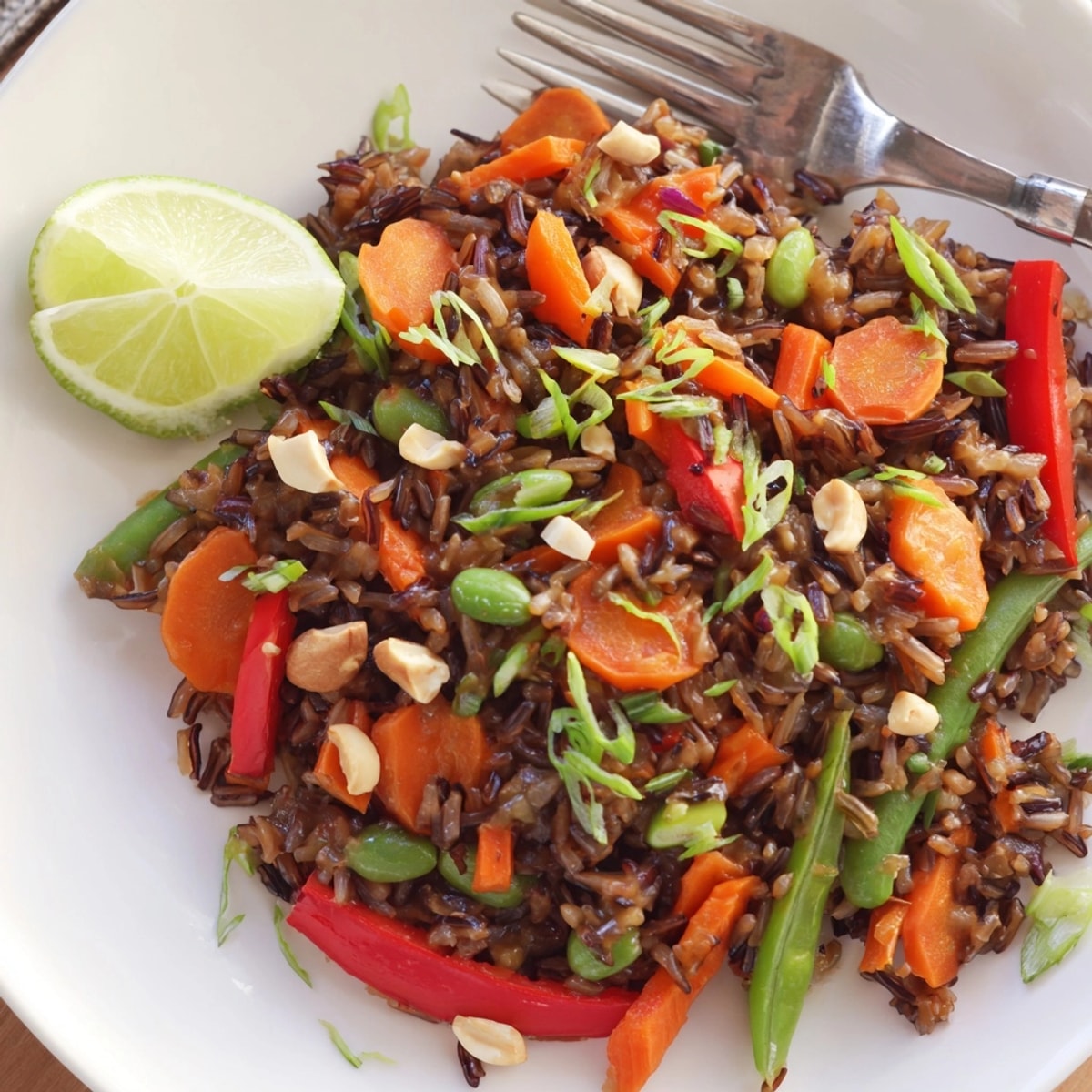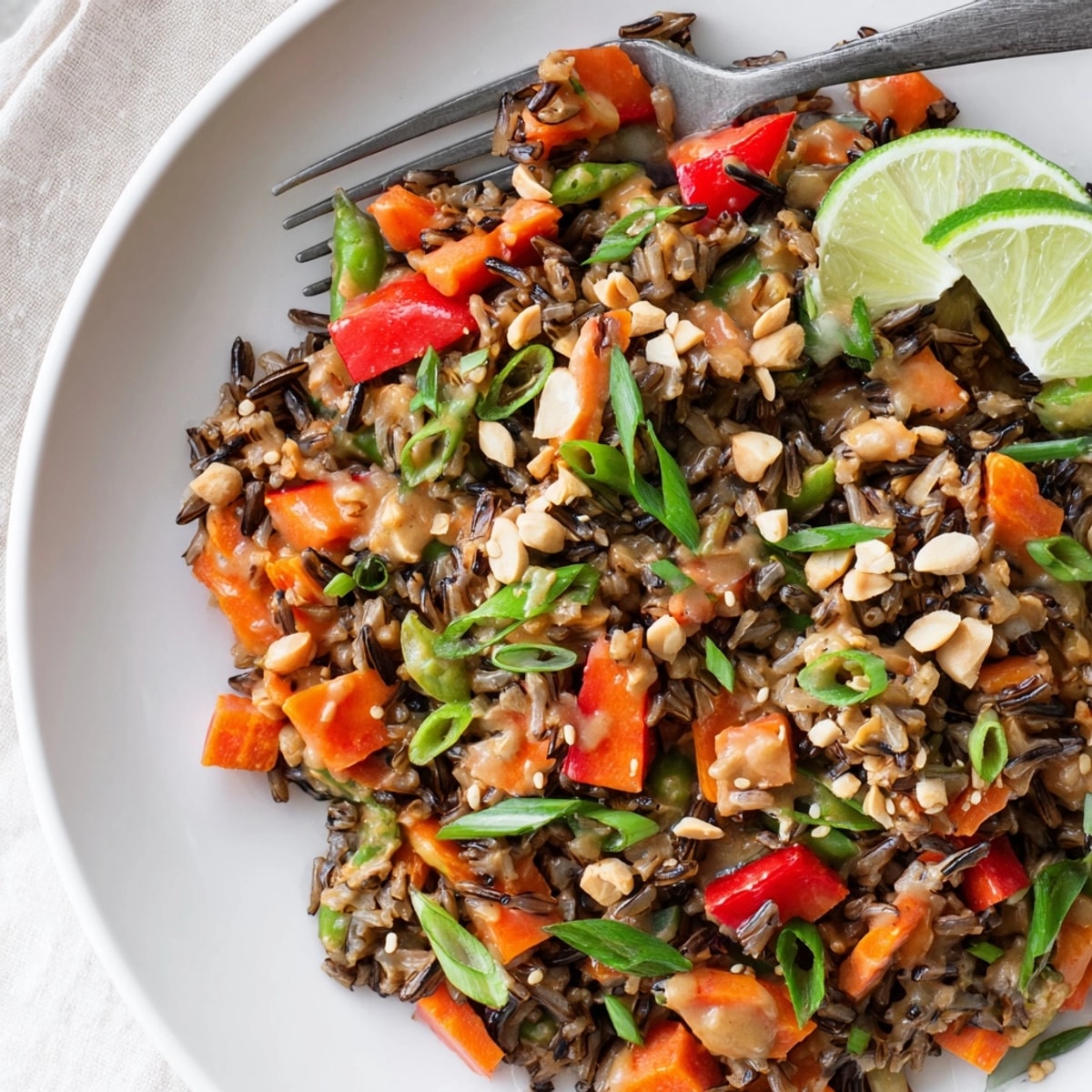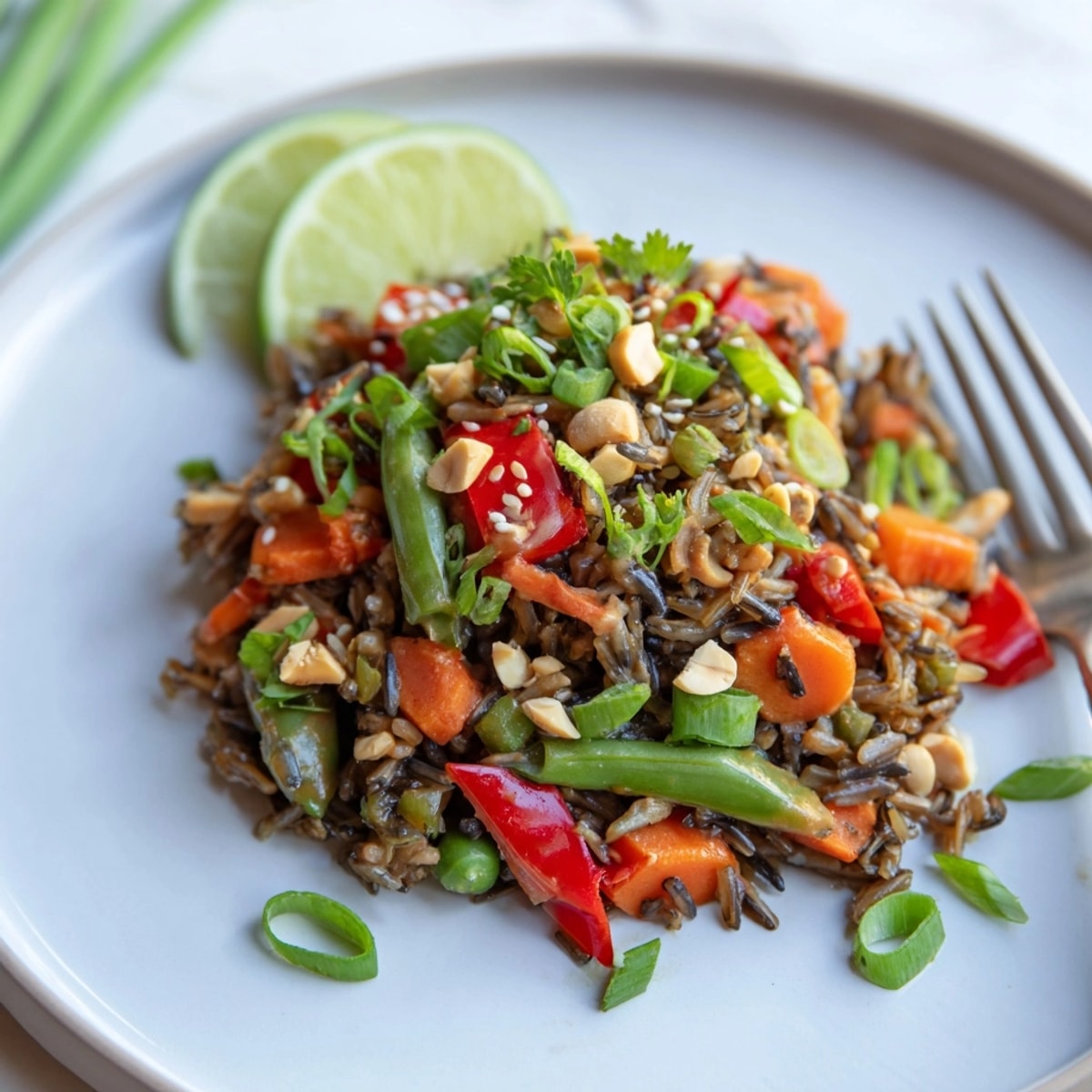 Save
Save This Thai Peanut Wild Rice Pilaf brings together tender wild rice, crisp-tender vegetables, and a creamy peanut sauce for a dish that always feels both hearty and refreshing. It started as a simple idea to use up leftover wild rice, but the vibrant colors and big flavors quickly made it a regular on busy weeknights and festive tables alike.
I first made this pilaf for a vegetarian potluck and there were no leftovers by the end of the night. It is now my go-to for lunch meal prep and easy shared dinners.
Ingredients
- Wild rice: brings a rich, toasty flavor and chewiness. Look for glossy, firm grains in the bulk bins or pre-packed bags
- Vegetable broth: infuses the rice with savory depth. Use a low-sodium variety to better control salt
- Coconut oil: enhances the rice's fragrance and brings authentic Thai flair. Choose virgin coconut oil for the best aroma
- Red bell pepper: adds a juicy sweet crunch and lively color. Select bright, firm peppers with glossy skin
- Carrot: provides earthy sweetness and vivid orange color. Choose carrots that are smooth and crisp
- Snap peas: offer mild sweetness and freshness. Go for bright green peas that snap when bent
- Green onions: give a mild, zingy heat and extra green notes. Slim stalks with crisp leaves are best
- Cilantro leaves: add citrusy, herbal lift. Use fresh bright leaves and avoid wilted bunches
- Creamy peanut butter: creates the luscious base for the sauce. Opt for natural peanut butter for real depth
- Soy sauce or tamari: ties the sauce together with salty umami. For gluten-free, always use tamari
- Lime juice: brings clean acidity and makes every flavor pop. Fresh limes yield the brightest taste
- Honey or maple syrup: adds gentle sweetness to balance the savory and tangy notes
- Toasted sesame oil: accentuates the nutty profile. Choose dark, fragrant oil for the richest aroma
- Freshly grated ginger: delivers a peppery punch. The freshest roots are firm and aromatic
- Garlic: builds foundational flavor. Always use fresh cloves for best results
- Roasted unsalted peanuts: give a satisfying crunch on top. Select peanuts with a golden color and fragrant aroma
- Toasted sesame seeds: add both texture and a delicate nutty accent. White or black seeds both work beautifully
- Lime wedges: wake up the whole dish just before serving
Instructions
- Prepare the Wild Rice:
- Combine wild rice and vegetable broth in a medium saucepan. Bring it to a rolling boil over medium-high heat then immediately lower the heat to maintain a gentle simmer. Cover tightly and let the rice steam for forty to forty-five minutes until the grains are tender and most of the liquid is absorbed. When done fluff thoroughly with a fork to separate the grains and spread out for quicker cooling if needed
- Make the Peanut Sauce:
- In a small mixing bowl vigorously whisk together peanut butter soy sauce lime juice honey toasted sesame oil grated ginger and minced garlic. Add warm water one tablespoon at a time whisking after each addition until the sauce is smooth glossy and pourable but not runny. Taste and adjust seasoning as needed. Set this aside so flavors meld
- Sauté the Vegetables:
- Heat coconut oil in a large skillet over medium heat until shimmering. Add diced bell pepper and julienned carrot. Sauté with frequent stirring for three to four minutes until the veggies brighten in color and become just slightly tender but still crisp. Stir in snap peas and cook for two more minutes until all vegetables are heated through yet still vibrant
- Combine Rice Vegetables and Sauce:
- Add cooked wild rice into the skillet with veggies. Drizzle generously with the prepared peanut sauce. Using two spatulas or a wide spoon gently toss and fold until rice and vegetables are evenly coated and warmed through for one to two minutes. Take care not to break up the vegetables
- Finish with Herbs and Serve:
- Remove the skillet from heat. Fold in the sliced green onions and chopped cilantro for a fresh herbal finish. Taste one more time and adjust with extra lime juice or soy sauce if you wish
- Garnish and Enjoy:
- Plate the pilaf in a large shallow serving bowl. Scatter the top with chopped roasted peanuts and toasted sesame seeds for crunch and visual appeal. Serve immediately with lime wedges on the side for individual squeezing
 Save
Save My favorite part is watching everyone drizzle extra lime over their plates at the table. The zip and zing of citrus brings the whole pilaf to life and always has my daughter reaching for seconds. There is always an immediate request for leftovers for tomorrow's lunchbox
Storage Tips
Leftovers store beautifully in a well-sealed container for up to four days in the fridge. I like to tuck a paper towel in the container to keep any excess moisture at bay. For best reheating add a sprinkle of water and cover with a plate or lid before microwaving. The steam keeps the grains soft without drying out the sauce
Ingredient Substitutions
If wild rice is not available try brown rice or even a blend for a similar chewiness and color contrast. Almond or cashew butter works in place of peanut butter for anyone with peanut allergies. Add a dash of extra sesame oil for richness. Feel free to use other crisp vegetables like zucchini broccoli or radishes for seasonal flair
Serving Suggestions
Serve this pilaf as a main course piled into deep bowls or as a vibrant side to grilled satay or roast vegetables. Double up on protein by adding seared tofu tempeh or poached chicken near the end. A light cucumber salad or quick-pickled radishes make excellent refreshing accompaniments
Cultural and Historical Context
This dish is inspired by the vibrant peanut sauces of Thai cuisine which balance richness with zest. While wild rice hails from North America it pairs beautifully with Southeast Asian flavors and texture-driven dishes. The fusion makes it approachable for weeknights and special enough for parties
Seasonal Adaptations
Use fresh sugar snap peas and young carrots in the spring for sweetest flavor. Roasted butternut or acorn squash can replace carrots in fall for a more autumnal vibe. Add shaved radish or quick-pickled vegetables as a garnish in summer for extra crunch. Choose fresh cilantro for purest flavor. Swap in almonds to avoid peanuts easily. Pilaf stays vibrant and flavorful even after a couple days in the fridge
Success Stories
Several friends have texted me pictures of their own versions from leftovers when they have made this at home. It is always fun seeing each family's take with their favorite veggie swaps or garnishes and they always ask for the recipe again
Freezer Meal Conversion
Though best enjoyed fresh this dish does freeze surprisingly well. Cool completely before sealing in a freezer bag. Thaw overnight and gently reheat with a splash of broth in a skillet to restore the creamy texture
 Save
Save This bright, hearty pilaf is sure to be a favorite whether served warm or chilled. Customize it each time for new flavors and enjoy drizzling with lots of lime!